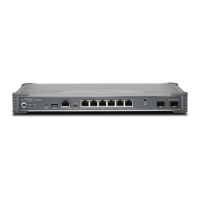• General Site Installation Guidelines for the SRX300 Services Gateway on page 16
Required Tools and Parts for Installing the SRX300 Services Gateway
To install the services gateway, you need the following tools and parts:
•
Phillips (+) screwdriver, number 2
•
Tie-wrap
•
Electrostatic discharge (ESD) grounding wrist strap
Related
Documentation
SRX300 Services Gateway Installation Overview on page 35•
SRX300 Services Gateway Autoinstallation Overview
The autoinstallation process begins any time a services gateway is powered on and
cannot locate a valid configuration file in the internal flash. Typically, a configuration file
is unavailable when a services gateway is powered on for the first time or if the
configuration file is deleted from the internal flash. The autoinstallation feature enables
you to deploy multiple services gateways from a central location in the network.
If you are setting up many devices, autoinstallation can help automate the configuration
process by loading configuration files onto new or existing devices automatically over
the network. You can use either the J-Web interface or the CLI to configure a device for
autoinstallation.
For the autoinstallation process to work, you must store one or more host-specific or
default configuration files on a configuration server in the network and have a service
available—typically Dynamic Host Configuration Protocol (DHCP)—to assign an IP address
to the services gateway.
Autoinstallation takes place automatically when you connect an Ethernet port on a new
services gateway to the network and power on the device. To simplify the process, you
can explicitly enable autoinstallation on a device and specify a configuration server, an
autoinstallation interface, and a protocol for IP address acquisition.
For more information about configuring autoinstallation, see the following topics:
•
Installation and Upgrade Guide for Security Devices
•
Monitoring and Troubleshooting Guide for Security Devices
Related
Documentation
• SRX300 Services Gateway Installation Overview on page 35
Copyright © 2016, Juniper Networks, Inc.36
SRX300 Services Gateway Hardware Guide

